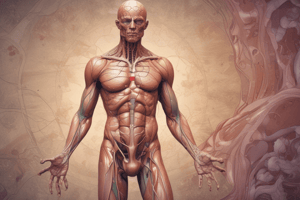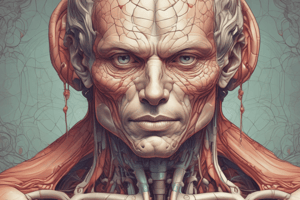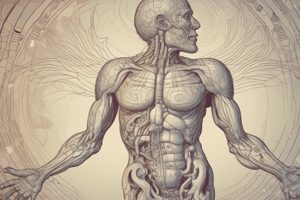Podcast
Questions and Answers
Which characteristic distinguishes the reproductive system from other systems in the human body?
Which characteristic distinguishes the reproductive system from other systems in the human body?
- It serves no essential function to the survival of the individual. (correct)
- It is essential for the survival of the individual.
- It does not impact other bodily systems.
- It operates independently without hormonal influence.
What key role do male and female reproductive organs perform in the continuation of life?
What key role do male and female reproductive organs perform in the continuation of life?
- They directly regulate the body's metabolism.
- They serve as the primary defense against pathogens.
- They facilitate nutrient absorption in the digestive system.
- They produce and store specialized cells essential for forming new individuals. (correct)
Beyond producing reproductive cells, what additional critical function do reproductive organs serve?
Beyond producing reproductive cells, what additional critical function do reproductive organs serve?
- Regulating body temperature through sweat production.
- Coordinating muscle movements and reflexes.
- Filtering toxins from the bloodstream.
- Secreting hormones that regulate sexual function. (correct)
What is the primary role of the reproductive system?
What is the primary role of the reproductive system?
Which of the following describes the function of gonads within the reproductive system?
Which of the following describes the function of gonads within the reproductive system?
What is the role of ducts in the reproductive system?
What is the role of ducts in the reproductive system?
What is the primary function of accessory glands associated with the reproductive system?
What is the primary function of accessory glands associated with the reproductive system?
What anatomical structures are collectively referred to as external genitalia?
What anatomical structures are collectively referred to as external genitalia?
What defines the reproductive tract?
What defines the reproductive tract?
How do the male and female reproductive systems differ fundamentally in terms of gamete production?
How do the male and female reproductive systems differ fundamentally in terms of gamete production?
After fertilization, what critical role does the female reproductive system fulfill regarding the zygote?
After fertilization, what critical role does the female reproductive system fulfill regarding the zygote?
What approximate quantity of sperm do the male testes produce daily?
What approximate quantity of sperm do the male testes produce daily?
What primary hormonal role do testes play?
What primary hormonal role do testes play?
Besides secreting hormones, what other critical function do testes perform?
Besides secreting hormones, what other critical function do testes perform?
Which process accurately describes the ovaries' contribution to female reproductive function?
Which process accurately describes the ovaries' contribution to female reproductive function?
What key hormonal function do ovaries perform?
What key hormonal function do ovaries perform?
Which statement properly describes the role of the uterine tubes in fertilization?
Which statement properly describes the role of the uterine tubes in fertilization?
What is the primary function of the uterus concerning embryonic development?
What is the primary function of the uterus concerning embryonic development?
Which statement accurately describes the connection between the vagina and the uterus?
Which statement accurately describes the connection between the vagina and the uterus?
How the male and female reproductive systems function with respect to the number of gametes ready for fertilization?
How the male and female reproductive systems function with respect to the number of gametes ready for fertilization?
Flashcards
Reproductive System
Reproductive System
A system of organs involved in producing offspring.
Gonads
Gonads
Organs that produce gametes (reproductive cells) and hormones.
Gametes
Gametes
Reproductive cells; sperm in males and oocytes in females.
External Genitalia
External Genitalia
Signup and view all the flashcards
Reproductive Tract
Reproductive Tract
Signup and view all the flashcards
Testes
Testes
Signup and view all the flashcards
Ovaries
Ovaries
Signup and view all the flashcards
Oocyte
Oocyte
Signup and view all the flashcards
Uterine Tubes
Uterine Tubes
Signup and view all the flashcards
Study Notes
- The reproductive system is not essential to the life of the individual, but it affects other systems.
- Male and female reproductive organs produce and store specialized reproductive cells that combine to form new individuals.
- They also secrete hormones that play major roles in maintenance of normal sexual function.
Structures of the Reproductive System
- The reproductive system ensures the continued existence of the human species.
- Reproductive structures include gonads, ducts, accessory glands, perineal structures, and the reproductive tract.
- Gonads are organs that produce gametes (reproductive cells) and hormones.
- Ducts receive and transport gametes, while accessory glands secrete fluids into ducts.
- Perineal structures are collectively known as external genitalia.
- The reproductive tract includes all chambers and passageways that connect ducts to the exterior of the body.
- Male and female reproductive systems are functionally different.
- Females produce one gamete per month and retain and nurture the zygote.
- Males produce large quantities of gametes, around half a billion sperm per day.
Male Reproductive System
- Testes (male gonads) secrete male sex hormones (androgens) and produce male gametes (sperm).
Female Reproductive System
- Ovaries (female gonads) release one immature gamete (oocyte) per month and produce hormones.
- Uterine tubes carry oocytes to the uterus.
- If sperm reaches oocyte, fertilization is initiated, and the oocyte matures into ovum.
- The uterus encloses and supports the developing embryo.
- The vagina connects the uterus with the exterior.
Studying That Suits You
Use AI to generate personalized quizzes and flashcards to suit your learning preferences.




